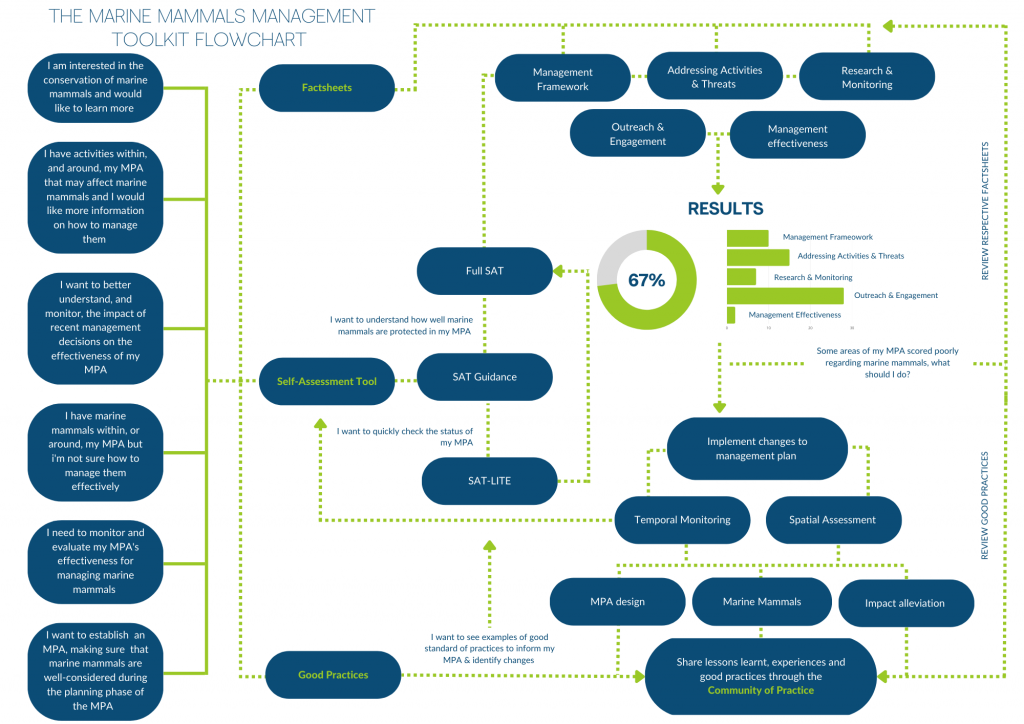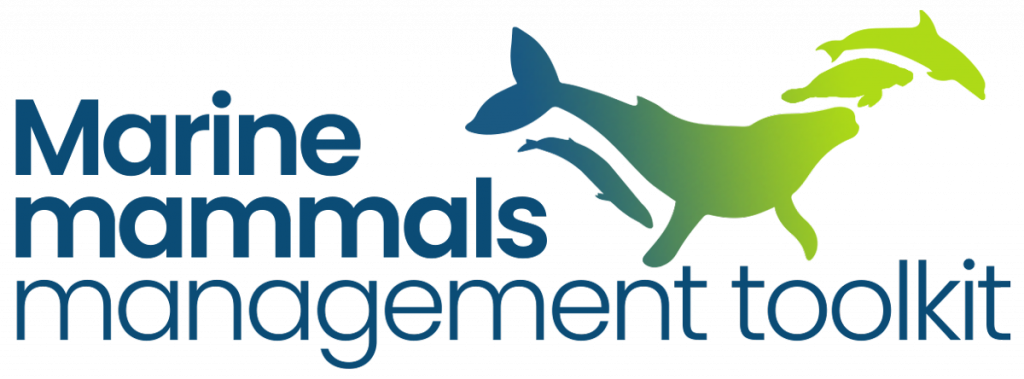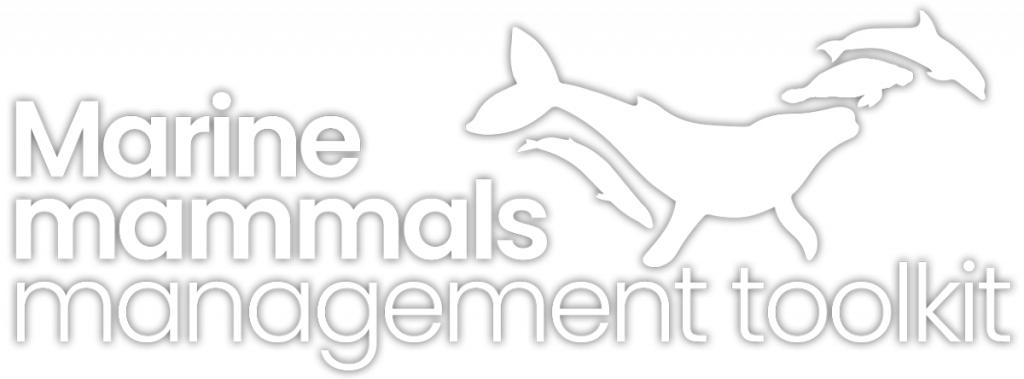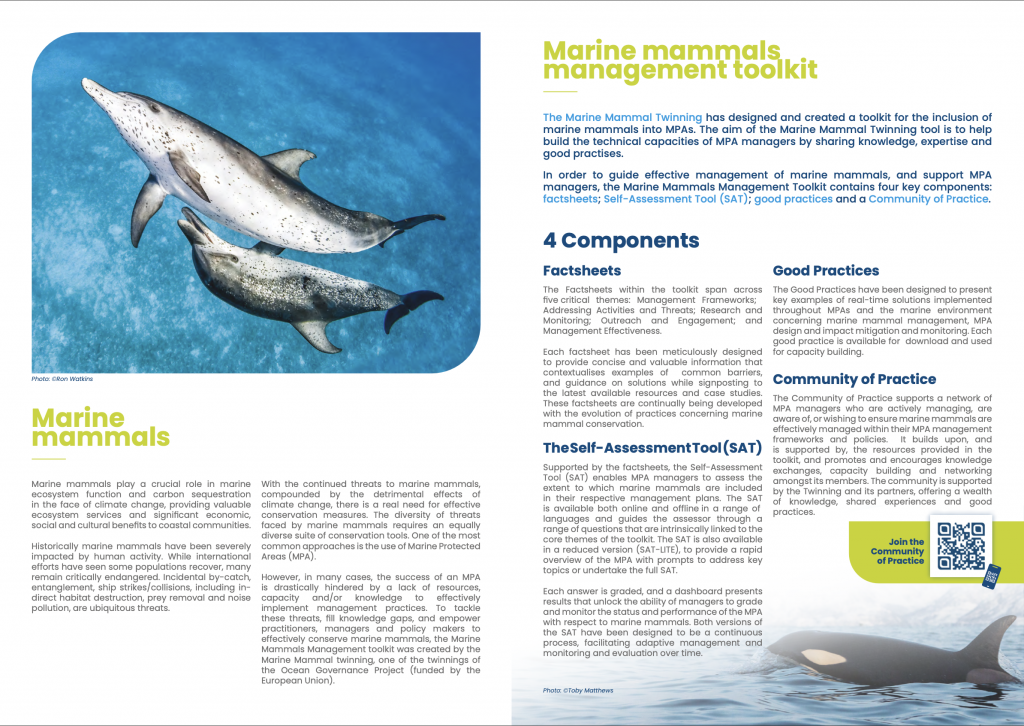Frequently Asked Questions
MPA managers can implement the Toolkit at any point throughout the MPA process; pre-establishment and planning; establishment; and monitoring and evaluation. The Self-Assessment Tool (SAT) can be utilised as a checklist to aid with management plan development, it can also assess the draft management plan to identify any gaps prior to be being adopted, and it is a valuable tool for long-term monitoring and evaluation of MPA effectiveness, allowing managers to practice adaptive management by identifying any gaps or weaknesses in their existing management plan. The Toolkit can also be used to showcase, and communicate, the strengths of the MPA with regard to reporting, capacity building and stakeholder engagement. Throughout each phase, the Factsheets, and Good Practices, as well as the Community of Practice (CoP), provide a valuable set of resources and information to better understand the outputs of the Self-Assessment Tool (SAT) whilst aiding with the development of specific management practices under the MPA management framework.
Where stakeholder consultations, or collaboration between different agencies, are needed, the Toolkit is available in over 25 different languages with the Self-Assessment Tool available to download in English, French and Spanish, as well as accessible as both offline (Excel) and online versions.
The Marine Mammals Management Toolkit is the only tool specifically dedicated to marine mammals. It is online resource with multiple purposes including capacity building that equips MPA managers with the knowledge and understanding to effectively manage marine mammals within, and around, MPAs. By using the Toolkit managers can gain insight into the level of protection afforded to marine mammals by an MPA’s management plan, identifying gaps, weakness and strengths, and the necessary actions needed to address them. This process allows MPA managers and management authorities to improve the effectiveness of marine mammal conservation strategies.
Yes, the Toolkit can be applied even if an MPA or management plan has not yet been established or adopted. The Self-Assessment Tool can be utilised as a checklist when developing an MPA management plan to provide key considerations of management actions for marine mammals. This can then be supplemented by the Factsheets and Good Practices to further tailor specific actions indicated in the management plan.
The Self-Assessment Tool can also be used to assess the draft management plan before it is adopted under the framework of the MPA allowing for an initial understanding of the effectiveness of the management plan and ultimately enable adjustments to be made based on any gaps or possible weaknesses identified. Where gaps are identified but there is limited knowledge on how to address these, the factsheets, and good practices, as well as the Community of Practice, are a great source of information and resources to aid the process.
The Self-Assessment Tool unlocks an MPA’s manager ability to understand how effective an MPA is at managing and conserving marine mammals. The Self-Assessment Tool can also be used to understand strengths and weaknesses of the MPA’s management plan as well as a tool to evaluate and monitor the MPA’s effectiveness regarding the management and conservation of marine mammals. It can be applied in a spatial-sense to provide a single time-bound assessment of the MPA, or can be utilised overtime at set intervals (built into the MPA management plan framework) for monitoring and evaluation purposes. Following successive assessments, MPA managers can use the outputs of the Self-Assessment Toolto direct resources to address gaps and weaknesses, enabling adaptive management and adjustments the management plan.
The results of the Self-Assessment Tool are presented in a clear and intuitive dashboard supporting communication with governing agencies, MPA users and general stakeholders – providing a valuable tool to determine actions needed for specific conservation measures.
The toolkit supports this process with the Factsheets and Good Practices providing valuable resources and information to address gaps in the MPA, improving marine mammal management, and the Community of Practice enables exchanges between other MPA managers, partners of the Twinning and mentors to discuss specific activities and learn from others where certain management actions may not have been effective.
To undertake the full Self-Assessment Tool or SAT-Lite you will need to have access to information specific to the MPA management plan. While the MPA manager(s) or management authority are likely to have the best knowledge and access to the information, the Self-Assessment Tool can be completed in different stages, giving the possibility for users to collect the needed information.
The factsheets provide an overview on a wide range of topics related to marine mammals and MPAs, including but not limited to; considerations for MPA management frameworks, how to address threats to marine mammals, research and monitoring considerations, outreach and engagement, improving management effectiveness and many more. Each factsheet aims to provide a case study to contextualise the information provided in the factsheet, relating to specific MPA’s or conservation cases, as well as citing a variety of external resources for further support.
The factsheets were designed to accompany and support the interpretation of the Self-Assessment Tool results, to better understand the areas of weakness of the MPA, as well as a stand-alone resource when wanting to learn more about specific aspects of marine mammal management within the MPA framework. The factsheets can be used by anyone with a specific interest in marine mammals or would like to learn more about certain activities and their respective threats to marine mammals.
Good Practices are practices that have been proven to work well, and produce good results, and are therefore recommended as a model on which to base ones’ actions. Good Practices can take the form of practical on-the-ground activities, strategies to improve social participation, economic or legal instruments, conservation techniques that significantly improve the amount of protection afforded to marine mammals, and even sustainable development is coastal and marine areas. An example would be to follow up-to-date guidance on effective MPA design, to ensure development is being led by sound, scientific decisions.
The Community of Practice (CoP) is a forum for MPA managers, users, and anyone interested in the conservation of marine mammals, or use of the Self-Assessment Tool (SAT). The CoP is open to marine users from around the world to exchange stories, knowledge and management practices whilst building relationships and expanding MPA networks with a common goal of ensuring that marine mammals are effectively protected within marine policy frameworks. In addition, the Community of Practice benefits from ‘Mentors’ – these positions are filled by partners of the Twinning, including Stellwagen Marine Bank Sanctuary; Mentors are on-hand to discuss specific management questions and share their experiences with regards to managing marine mammals.
You will need to sign up via the registration link on the CoP Homepage, titled “Join the Community of Practice”. Once you have registered with the mailing group, you can post questions in the Self-Assessment Tool section, and it will be visible to all other members of the Community of Practice.
We have developed a handy flow chart designed to help you decide which version of the self-assessment tool (SAT) will be most beneficial to you. With only 50 short answer questions, the SAT-LITE aims to provide recommendations on ‘next steps’ and acts as an indicator for the need to undertake the full SAT. The SAT-LITE can be used at intermediary stages between full assessments to provide more details on how the management plan is progressing. The chart (below) can be downloaded here.
To learn more, please visit our Supporting Resources page where you’ll find our first training video introducing the Marine Mammals Management Toolkit. We currently have 3 more videos in the pipeline that will provide detailed instructions on how to use the self-assessment tool (SAT) and interpret your results, so watch this space!
If you do require support and/or guidance in undertaking the Self-Assessment Tool, or would like to learn more about the Toolkit and discuss additional training within your region, the Marine Mammal Twinning team is available for support at this email: ocean-governance@biodiv-conseil.fr




